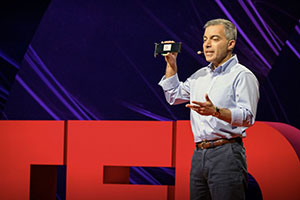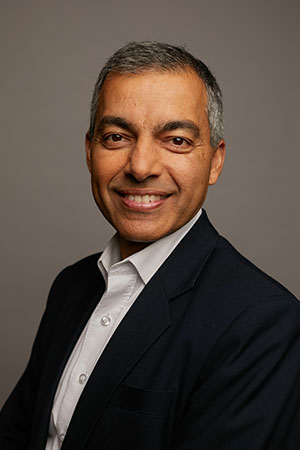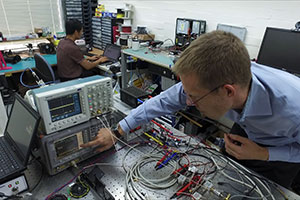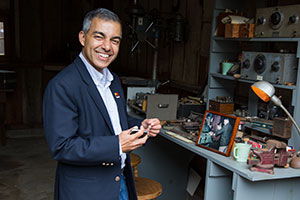 Information can be considered the lifeblood of many organizations by virtue of the competitive and strategic advantage it can provide. It is clearly an asset worth protecting. According to Dr. Vikram Sharma, CEO of Quintessence Labs, encryption provides one of the strongest mechanisms to protect this valuable asset. The key to data security is to understand what data you have and what value it brings to the entity, and protecting it appropriately.
Information can be considered the lifeblood of many organizations by virtue of the competitive and strategic advantage it can provide. It is clearly an asset worth protecting. According to Dr. Vikram Sharma, CEO of Quintessence Labs, encryption provides one of the strongest mechanisms to protect this valuable asset. The key to data security is to understand what data you have and what value it brings to the entity, and protecting it appropriately.
Based on quantum physics, the two key elements of QuintessenceLabs’ offerings are true random number generation, which is an essential element of successful encryption, and the use of quantum effects to securely transport encryption keys from one location to another. These capabilities are integrated within a software suite to provide very strong data protection. And while the technology sounds complicated, it has been carefully developed to be simple to use and flexible enough to work in any corporate environment.
While the nature of cyber-security and data threats changes, the nature of quantum physics doesn’t, and this provides a unique opportunity for QuintessenceLabs to adapt to the changing market needs. The key to this says Vikram, is agility.
In the simplest of terms, quantum physics predicts very strange things about how matter works, that are at odds with how things work at the human scale. Quantum phenomena can behave like particles, located in a discrete space, or they can act like waves distributed all over space or in several places at once.
QuintessenceLabs use these unique properties to provide its unique solutions.
The company is fast becoming recognized as a world leader in the protection of data and through many awards. Recently QuintessenceLabs was selected to join the 2020 Global Innovator Community by the World Economic Forum, the first Australian company to be so recognized. This year, QuintessenceLabs also won the 2020 Global Cybertech100 Award as one of the most innovative companies in the financial sector.
QuintessenceLabs is a proud Canberra company and continues to maintain its headquarters in the ACT.
Serendipitous beginnings
 Vikram says the way QuintessenceLabs started was unusual. After running information technology businesses in Canberra for many years, Vikram had the opportunity in 2005 to go to graduate school in the US.
Vikram says the way QuintessenceLabs started was unusual. After running information technology businesses in Canberra for many years, Vikram had the opportunity in 2005 to go to graduate school in the US.
“An amazing program typically designed for those Fortune 500 people who had been identified for key C suite roles and could benefit from a one year very intense, immersive environment, to learn the latest tools and come out as better managers.
The 48 people in our cohort represented 22 countries and 42 fortune 500 companies including folks from British Petroleum, Motorola, NASA, Lockheed Martin, and a range of the biggest brand names we know. They also had six people who were entrepreneurs and I guess I was one of those added to the mix to provide a different perspective,” says Vikram.
Vikram says that it was somewhat intimidating when he first saw the profiles of the attendees. “One person was from an automotive company and in charge of an annual budget of around $2 billion. And here I was running a small business based in Canberra turning over a few million.”
“The year was transformational”, says Vikram.
“It opened my eyes to a range of business issues and opportunities.”
The course work provided a lot of insight, but Vikram said that this didn’t really compare with what he gained from the others in the program. “They had years of experience between them and their diverse backgrounds provided so much experience and knowledge.”
At the end of that program, Vikram decided to take six months out and immerse himself in Silicon Valley to decide what to do next.
Vikram has lived in Canberra for 40 years, and this is home. His father was in the High Commission to Australia in the early 80s and when he moved to his next post, Vikram decided to stay on to complete his studies. He started an undergraduate degree in physics but later transferred into computer science - this is where serendipity comes to play.
During his time in Silicon Valley, Vikram decided to sit in on some physics classes.
“Physics must be embedded in my psyche. The classes were taught by this guy who was amazing – a Nobel laureate who went on to become the US Energy Secretary. He was well known for example for proposing physics-based solutions to containing major oil spills.  While the physics was interesting, what really piqued my interest was to learn how we were on the cusp of creating quantum systems that don't exist in nature, almost like building super materials. We were about to be able to manufacture these non-existent materials which meant that a host of new capabilities were about to open up”, says Vikram.
While the physics was interesting, what really piqued my interest was to learn how we were on the cusp of creating quantum systems that don't exist in nature, almost like building super materials. We were about to be able to manufacture these non-existent materials which meant that a host of new capabilities were about to open up”, says Vikram.
Quantum computers had been, at least conceptually, in development since the early 80’s and many big players including IBM, Google and Microsoft have accelerated the development of this capability in recent years.
Vikram says “imagine if you could detect cancer at a single cell level through advanced imaging and then send in a nanobot to zap that cell. Maybe we would have a permanent cure. These were some of the new applications being developed.”
The application of quantum physics that realty captured Vikram’s attention was cyber-security. He considered setting up a startup in this space but the science was still too immature at the time. So, he did some investigation and found that back in Canberra, the ANU was about to embark on some cutting-edge research in this field.
“I contacted the professor and he said, if you do come back to Canberra let me know. And we'll see whether there's a place for you on the team.
As it turned out, my wife was expecting our second child and we decided that we wanted to bring him up in Australia and in particular in Canberra. So, we came home, and I wound up joining this group at the ANU.”
Vikram says that the team had some world firsts demonstrating particular capabilities of quantum for cyber security. The team was awarded the 1Eureka Prize in 2006 for this work.
In 2007, I set out trying to raise some capital. We had some great discussions, but the Global Financial Crisis was unfolding – so timing is everything or not”, says Vikram with a knowing laugh.
Vikram finally managed to invest some personal capital alongside a consortium of private investors and a matching grant from Ausindustry in 2008. The company was seeded with some of the research from the ANU and the IP Vikram owned as part of his PhD.
From research to business
Vikram says that for at least half of its journey, QuintessenceLabs has been very much on the frontier of science, well ahead of the commercial adoption curve.
“What you get out of university research is just the seed of an idea, and it takes a long time, particularly if it's deep tech, to take that seed, refine it, mature the science, figure out how you can convert science to technology, map that technology to solving real world problems and then produce something that can be physically produced in a repeatable, economical and reliable way.
It took us until 2014/15 to get to that level. That was about 6 years where we had to balance sustaining ourselves with limited revenues while fully investing in the technology,” says Vikram.
The core product
 Quantum physics is not for the faint hearted, but Vikram explains that QuintessenceLabs have taken something that is quite complex and make it simple to apply across its range of customers.
Quantum physics is not for the faint hearted, but Vikram explains that QuintessenceLabs have taken something that is quite complex and make it simple to apply across its range of customers.
“Historically, says Vikram, people put big walls around their IT systems like a firewall. They are like the old walled city used to keep the bad guys out. But sooner or later a bale of hay comes in on a cart with someone hiding inside. The same kind of thing happens with cyber-security. To address this, most enterprises are moving to the idea of layered defense: multiple layers of cyber-security working together.
One of the strongest layers is enterprise-wide encryption: if you have anything that's sensitive, encrypt it! Even if the bad guys are able to access it with some malware, or an insider extricates the data, it will be of limited or no value to them, because it is well protected.”
Vikram says that encryption is relatively mechanical. “The big issue is how to manage the encryption keys – think of hotel rooms, but on a huge scale. In the IOT2 world, there are now hundreds of millions of billions of encryption keys. This is further complicated in a typical data centre by the heterogeneous nature of the technology being used. It could have IBM, Hewlett, Packard, EMC, Oracle, SAP operating together and not too many technologies can span this breadth of hardware and software.”
The other key challenge, says Vikram, is that some of today’s most widely-used encryption technologies will be broken once a quantum computer of scale becomes a reality. “So, once we have a quantum-enabled adversary, we need to find other ways to protect that data. This is why we have a portfolio of technologies that solve today's problems, but that also help keep data safe in the future.”
Servicing the needs of different sectors
QuintessenceLabs works across a range of industry security-driven sectors, and while the fundamental principles remain the same across enterprises, how you interface into the existing systems is critical.
“We are like the plumbing of cyber-security infrastructure. We are the foundation generating the highest quality encryption keys using a quantum process called quantum tunneling. This is a world-leading Australian technology, generating a billion random numbers per second. All from something the size of a cell phone. This goes into a software stack, which groups those random numbers into encryption keys. And then it manages those keys, ensuring that only people who should get access to the data do so, a bit like a hotel concierge. The core product is constant but the way it integrates into specific applications is what varies.”
Reaching customers
Strategic partnerships were very valuable in helping us access those multiple markets, says Vikram.
“It’s something we're really focused on from the beginning, because cyber-security knows no boundaries. We can say that we were born global by default. We established our US office very early on and it has three primary functions: business development for the US market, managing supply chain and manufacturing in San Jose, and that strategic partnership piece. We now have a number of US companies who are strategic partners, and we integrate their technology with our core capabilities to give customers a full-stack product to solve a complete problem. Partnering with mid-tier companies, and having access to their customer base, has also accelerated our sales pipeline.”
QuintessenceLabs has recently developed partnerships in the UK and Singapore with these being the next two target markets.
Vikram says that the hardware is produced and distributed out of the US.
“Our contract manufacturer builds our quantum random number generators, slots these into a server, installs our software, tests the whole device, boxes it up in into QLabs-branded boxes and sends them off directly to the customer. It’s all zero touch from us. This is the beauty of these partnerships.”
Being a dispersed company
The company is currently made up of about 60 staff members, all highly skilled in the company’s core capabilities. Vikram focuses on keeping the company lean: anything that is non-core is outsourced. This is part of the business strategy that allows the company to focus on what it does best.
The majority of QuintessenceLabs staff is based in Australia, with the others mainly in the US.
“At the moment, our revenues are about 50% from the US and the balance out of the EU and Australia,” says Vikram.
Vikram believes that this helped deal with COVID. “We were used to the format of virtual meetings, working across time zones and having the team in multiple locations. We added regular calls to update teams and reviewed our written documentation. Working with contract manufacturers requires a certain level of maturity and discipline to make sure your specifications and documentation are absolutely perfect, so that they can build the product accurately. We have automated platforms that those manufacturers can use to check the product, which we set up well before the pandemic.”
Vikram also credits the IT team. “They had an inclination that we may have to move to working from home so they provisioned for this early. We also had to find better ways of communicating and supporting team members to make sure they were doing okay and pulling together on projects.”
“The people management side is almost harder than the tech management side”, says Vikram.
QuintessenceLabs recently designed and moved into new facilities, which Vikram welcomed as an opportunity to bring the team back together.
“Cohesiveness and team engagement are not just important for the staff, but also for demonstrating outcomes for our stakeholders”, says Vikram.
Working from home has had its challenges, but has also created a range of opportunities, including in expanding QLabs’ cyber-security offering. The office perimeter is now widely dispersed across households and it is accessed by smart phone, laptops and tablets. There has been a well-documented increase in adversaries seeking to exploit this. For QuintessenceLabs this has created an opportunity to extend their product line to support cloud-delivered applications, to effectively protect data in this very diverse, open and dispersed environment for both large and smaller enterprises.
Some lessons learned
Vikram says that the challenges of 2020 have highlighted many things to him.
- When working with customers in a virtual way, you need to become agile and more responsive. There seems to be a greater expectation of immediacy or near immediacy in your interactions. And the downside of being so well connected is that you are expected to be connected all the time.
- We found that we can effectively leverage our partners’ boots on the ground to a much greater extent than we had done previously. Over the next year, we expect to announce a couple of partnerships with large global players which will really give us that access to people on the ground in virtually every geography and the backing of well-respected brands.
- Many start-ups ask me about how you set up a fair partnership – we find that it depends on the sector. Do some market research and you will find precedents of what is typical within your particular sector. It depends on who's doing what and who's contributing what to the composite sale; is it a distributor, reseller relationship or is it a strategic partnership? These all have a bearing on what any revenue split looks like.
- Success takes a sustained effort over many, many years, and many tough choices. What sustains you is your conviction and your commitment that you are going to build this business. It’s not just about making money, but having a sense of a greater purpose that is really important to sustain you and driving motivate you through those challenging times.
- One lesson that should not surprise anyone is to carefully choose the team that you build around you. Of course, you need those with the right skills, but also choose people who have complementary skills to yours. No matter how good you might be, or how broad your skill set is, there are always things when running a business where you really benefit from having those complementary skill sets around you.
- Be receptive to signals about what you are developing and/or producing from your partners, your own team and from the market. Being able to adjust and adapt to those signals is critical.
- Look at your potential export markets critically. On the surface, things might look similar, for example, the use of English in many countries. But there are many variations relating to how you sell, what you sell, how you message, and the expectations that your customers have. In spite of the similarities on the surface, when you actually go to do business, there are nuances that you need to adapt to in order to succeed.
- You need to be in the market educating and talking to people, whether to a group of three or three hundred. It’s about being out there at every opportunity and spreading the message. Remember that you are building your brand.
1 https://australian.museum/get-involved/eureka-prizes/
2 Internet of Things.
An initiative of the ACT Chief Minister’s Export Awards
The ACT Chief Minister’s Export Awards aims to showcase and celebrate the achievements of Canberra region exporting businesses. These Canberra and region businesses transact significant parts of their business activities (legal, accounting, production, research etc.) through the ACT as they develop international markets. The ACT Chief Minister’s Export Awards aims to build the pathway for new and emerging Canberra region businesses seeking to internationalise their business. If you are a new or existing exporting businesses in the Canberra region, you can access a range of support as well as network with other exporting businesses, including
The ACT TradeStart Program helps ACT exporters to achieve long term success in international markets. The TradeStart program allows the ACT Government to work closely with Austrade and access key Austrade resources such as their export database, trade mission activities, their off-shore offices, intelligence and international connections for the trade and investment activities to support ACT exporters.
The International Business Engagement Program is being delivered by Canberra Business Chamber on behalf of the ACT Government. Its main objective is to maintain, rebuild and find new opportunities for Canberra and region businesses to engage internationally. The program focuses on building the Territory’s exporting community; providing training and support by facilitating seminars and workshops; creating links between local industry and other government support programs; assisting the ACT Government in co-ordination of business trade delegations (outbound and inbound).


